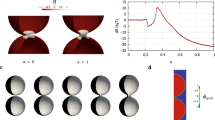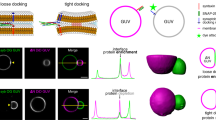Abstract
MEMBRANE fusion is the central event in biological processes as diverse as secretion, fertilisation, endocytosis and pathological cell fusion, but as yet its mechanism is poorly understood1. To elucidate this mechanism, bilayer phospholipid vesicles have been used extensively as models for interacting biomem-branes2–5. As a result of studies involving differential scanning calorimetry and freeze-fracture electron microscopy, it has been suggested that vesicles made from acidic phospholipids can fuse when exposed to divalent cations3–6. For phosphatidylserine vesicles, the ‘critical’ Ca2+ concentration for membrane fusion seems to be ∼ 1 mM, at which concentration a drastic increase in the permeability of the vesicle membranes has also been reported3. The techniques used to demonstrate ‘fusion’ in this system do not exclude molecular mixing of interacting membranes by mechanisms other than genuine fusion. In the latter case, the membrane-bounded internal compartments of two separate vesicles must become confluent in a process which transfers the contents of the initial vesicles to the resulting vesicle. It is possible, however, that Ca2+ may cause rupture of the lipid vesicles, with subsequent reassembly of the membrane fragments to form larger non-vesicular structures. If this is occurring, bilayer vesicles are poor paradigms for biological membrane fusion. One may predict the likelihood of vesicle fusion by calculating their energy of interaction due to electrostatic repulsion and electrodynamic attraction7. This approach shows that the addition of 1 mM Ca2+ to a suspension of phosphatidylserine vesicles is unlikely to reduce electrostatic repulsion between liposomes sufficiently for any but a fraction of the smallest ones to approach to 0.8 nm separation. This finding suggests that vesicles cannot approach closely enough to fuse and supports the notion that Ca2+ may initiate vesicle lysis and reassembly. We report here experimental support for vesicle lysis, based on the redistribution of a marker for the aqueous phase between vesicles and the external compartment on exposure to divalent cations.
This is a preview of subscription content, access via your institution
Access options
Subscribe to this journal
Receive 51 print issues and online access
$199.00 per year
only $3.90 per issue
Buy this article
- Purchase on Springer Link
- Instant access to full article PDF
Prices may be subject to local taxes which are calculated during checkout
Similar content being viewed by others
References
Poste, G. & Nicolson, G. L. (eds) Cell Surface Reviews Vol. 5 (North-Holland, Amsterdam, 1978).
Papahadjopoulos, D. & Poste, G. Biophys. J. 15, 945–948 (1975).
Papahadjopoulos, D. et al. Biochim. biophys. Acta. 465, 579–598 (1977).
Maeda, T. & Ohnishi, S.-I. Biochem. biophys. Res. Commun. 60, 1509–1516 (1974).
Prestegard, J. H. & Fellmeth, B. Biochemistry 13, 1122–1126 (1974).
Papahadjopoulos, D., Vail, W. J., Pangborn, W. A. & Poste, G. Biochim. biophys. Acta. 448, 265–283 (1976).
Gingell, D. & Ginsberg, L. in Cell Surface Reviews, Vol. 5 (eds Poste, G. & Nicolson, G. L.) 791–833 (North-Holland, Amsterdam, 1978).
Papahadjopoulos, D., & Watkins, J. C. Biochim. biophys. Acta 135, 639–652 (1967).
Papahadjopoulos, D. Biochim. biophys. Acta 211, 467–477 (1970).
Papahadjopoulos, D., Nir, S. & Ohki, S. Biochim. biophys. Acta 266, 561–583 (1972).
Papahadjopoulos, D., Hui, S., Vail, W. J. & Poste, G. Biochim. biophys. Acta 448, 245–264 (1976).
Allen, R. J. L. Biochem. J. 34, 858–865 (1940).
Papahadjopoulos, D., & Bangham, A. D. Biochim. biophys. Acta 126, 185–188 (1966).
Author information
Authors and Affiliations
Rights and permissions
About this article
Cite this article
GINSBERG, L. Does Ca2+ cause fusion or lysis of unilamellar lipid vesicles?. Nature 275, 758–760 (1978). https://doi.org/10.1038/275758a0
Received:
Accepted:
Issue Date:
DOI: https://doi.org/10.1038/275758a0
This article is cited by
-
Direct quantitative detection of Doc2b-induced hemifusion in optically trapped membranes
Nature Communications (2015)
-
Natural channel protein inserts and functions in a completely artificial, solid-supported bilayer membrane
Scientific Reports (2013)
-
Ca2+-induced fusion of phospholipid vesicles monitored by mixing of aqueous contents
Nature (1979)
-
Fusion or lysis of vesicles by Ca2+?
Nature (1979)
-
Fusion or lysis of vesicles bu ca2+ (reply)
Nature (1979)
Comments
By submitting a comment you agree to abide by our Terms and Community Guidelines. If you find something abusive or that does not comply with our terms or guidelines please flag it as inappropriate.



